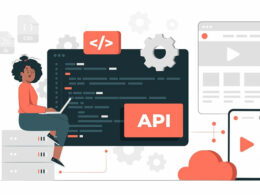The custom software development market was worth $29.29 billion in 2022 and is expected to grow, with a CAGR of 22.4% anticipated between 2023 and 2030, highlighting the rising demand for software development services.
Developing custom software can be transformative, but navigating the journey requires careful planning and informed decisions. This guide reviews the steps and considerations in custom software development, empowering you to approach your project confidently.
Custom software development steps
Before starting the project, set realistic expectations for costs and development timeframe. Consider technologies and frameworks aligned with your project goals and future needs. Don’t forget to decide what robust security measures you’ll implement to protect user data and comply with regulations. Moreover, consider scalability and future-proofing: design your software to accommodate potential growth and evolving needs.
Now, let’s get to the actual steps of custom software development services.
Define your needs & goals
Consider your future product’s basic idea, target audience, and realization at this step. Answer the following questions to proceed:
- What do you want to build? Identify the problem you want to solve or the opportunity you wish to seize.
- Who will use your product? Why? Outline your target users and their specific needs.
- How can the idea be implemented? Determine the core functionalities and features of your software.
- How can I measure the process and progress made? Establish clear success metrics to measure the impact of your project.
When the idea is clarified, it is time to move further to bring the project to life.
Choose a development approach
There are several approaches to custom software development. Choose based on your budget, project’s requirements and goals, length, and scope. The options are:
- In-house development: requires technical expertise and internal resources but offers complete control.
- Outsourced development: leverage external expertise for cost-efficiency and specialized skills. Consult custom software development services providers for your project and get expert commentary.
- Hybrid approach: combine in-house and outsourced resources for tailored flexibility.
In the case of selecting a second or third option, an additional search for a reliable partner can take some time. To choose the right development company, evaluate the experience, portfolio, and expertise relevant to your project to choose the right partner for outsourced or hybrid development. Then, assess communication styles, cultural fit, and project management methodologies. Finally, negotiate clear contracts outlining scope, deliverables, timelines, and costs.
Select the proper development methodology
Choosing the right software development strategy depends heavily on the specifics of your project and its context. There are several widespread approaches in the software development domain.
Agile. Iterative and adaptable, suitable for dynamic projects with evolving requirements. Promotes flexibility and rapid feedback but requires strong team communication and collaboration. According to Statista, almost 37% of respondents stated using an Agile method for software development in 2022.
Waterfall. Structured and sequential, ideal for well-defined projects with fixed requirements. Offers predictability but can be inflexible to changes.
Lean. A philosophy emphasizing waste reduction and maximizing value delivery. It can be applied alongside other methodologies to focus on efficiency and customer needs.
Hybrid. Combines elements of the above-mentioned approaches.
By carefully considering your project context and exploring various options, you can make well-informed choices that set your software development up for success.
Start the development process
That is where the actual development process begins! At this step, the team of software engineers, business analysts, QAs, and designers concentrate on the following activities:
- Requirements gathering and documentation: define functionalities, user stories, and technical specifications.
- Design and prototyping: create mockups, wireframes, and interactive prototypes to refine user experience.
- Development: implement functionalities and features using chosen technologies and tools.
- Testing and quality assurance: rigorously test functionality, performance, and security before launch.
- Deployment and maintenance: launch your software and provide ongoing support, updates, and bug fixes.
Remember, custom software development is a collaborative journey. By clearly defining your needs, choosing the right approach, and partnering with skilled developers, you can build a software solution that empowers your business and delivers exceptional value.
MVP development
How to build an MVP app? Developing a full-fledged software product can be a daunting and expensive task. At this point, the concept of MVP, or Minimum Viable Product, comes in. An MVP allows you to test your idea with real users quickly and efficiently, gathering valuable feedback before investing heavily in development.
MVP development is a popular approach to launching new products, particularly in software development. It means creating a version of your product with enough features to be usable by early adopters and to gather valuable feedback.
Benefits
MVP benefits from the unique focus on rapid learning cycles, early user feedback, and minimized upfront costs. The additional pros of this approach include the following:
Faster time to market: launch your product quickly and test it with real users without investing much time and resources in building a complete product.
Reduced risk: validate your product idea before significant investments in development. It helps you avoid building a product that nobody wants.
Gathered feedback: get valuable feedback from early adopters to improve your product and ensure it meets user needs.
Iterative development: use the feedback to iterate on your product and develop new features based on user demand.
Difference between MVP and full-scale development
The development process for MVP is similar to building a complete product and involves developers, designers, QA specialists, etc. Nevertheless, it implies some differences. Here’s a breakdown of their key distinctions:
Scope & focus
- MVP: narrowly focused on validating core functionalities and solving a specific problem for early adopters.
- Full-scale: encompasses the complete vision of the product with all features and functionalities intended for a broader audience.
Time & cost
- MVP: faster development due to limited features, leading to lower initial cost.
- Full-scale: requires more time and resources for comprehensive development, resulting in higher costs.
Risk & uncertainty
- MVP: lower risk as it allows testing and iteration before significant investment.
- Full-scale: higher risk due to upfront investment without user feedback, potentially leading to wasted resources if the product doesn’t resonate.
Flexibility & iteration
- MVP: highly flexible, allowing rapid adjustments based on user feedback and market response.
- Full-scale: less flexible, making changes post-launch more complex and costly.
Target audience
- MVP: targets early adopters willing to provide feedback and tolerate potential bugs/limitations.
- Full-scale: targets a broader audience with a fully polished and feature-rich product.
The choice of development approach will depend on the particular circumstances and project characteristics. For example, if market research strongly indicates a need for your product, full-scale development might be justified. If you need to gather user feedback to refine and improve the product’s idea, consider using MVP.
Conclusion
Custom software development comprises various stages, including defining goals, choosing a development approach, the development process, testing, deployment, and maintenance. It is always optional to choose full-scale development: an MVP approach can bring you more market insights and tailor your product’s features and functionalities to target audience expectations.
- Design Collaboratively: UX/UI Apps Like Figma - April 28, 2024
- Unlocking Capabilities: What is JavaScript Used For? - April 28, 2024
- Creative Collages: Designing with Apps Like PicCollage - April 27, 2024









